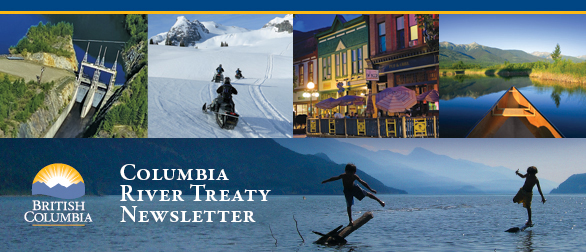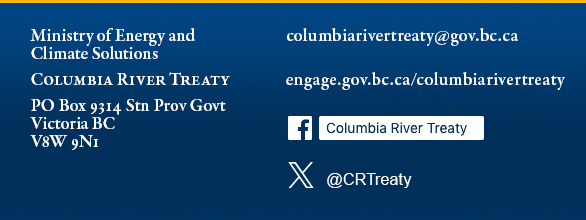Columbia River Treaty
Edition: September 2021

Treaty Fact: How is salmon restoration being addressed in modernization of the Columbia River Treaty
Sep 28, 2021
Exploring the feasibility of salmon returning to the Upper Columbia River is an important priority in the ongoing work to modernize the Columbia River Treaty. It is being addressed both within the Treaty and outside of it.
Though salmon passage up the river was blocked by the Grand Coulee Dam in 1939, well before the Treaty was in place, there are some factors related to salmon survival in the Upper Columbia that are directly impacted by Treaty operations, and so must be part of modernization discussions. Salmon reintroduction has been raised at the Canada-U.S. negotiating table, including at the 8th round of discussions in September 2019, where representatives of the Ktunaxa, Secwépemc and Syilx Okanagan Nations presented to the U.S. delegation on this topic.
In Canada, there is significant research underway to explore how ecosystems could be considered and ideally enhanced in a modernized Treaty. To deliver this work, the Canadian Negotiations Advisory Team established an Ecosystem Function Subcommittee, led by three Columbia Basin Indigenous Nations, and including representatives from Environment and Climate Change Canada, B.C. Ministry of Forests Lands, Natural Resource Operations and Rural Development, the Upper Columbia Basin Environmental Collaborative and consultants.
Their work focuses on four broad ecological themes:
- ecosystem productivity;
- floodplain/riparian/wetlands;
- river and reservoir ecosystems; and,
- anadromous (ocean-going) fish species, including salmon.
The results are informing Canada’s negotiating positions on the Treaty, especially in terms of how much flexibility is needed in Treaty operations to support a functioning ecosystem. Additional information on these efforts can be found on the CBRAC website.
Outside of the Treaty, salmon restoration is being addressed by the Columbia River Salmon Reintroduction Initiative (CRSRI). The CRSRI brings together five governments: the Ktunaxa, Secwépemc, and Syilx Okanagan Nations, Canada and B.C., to explore the reintroduction of salmon on the Canadian side of the Columbia River.
The CRSRI is Indigenous-led and guided by several distinct working groups and committees. Their long-term vision is to return fish stocks for Indigenous food, social and ceremonial needs, and to benefit the region’s residents and ecosystems. The CRSRI has recently released their 2020/21 Annual Report, which provides a visual summary of their second year of activities.
As work continues on the modernization of the Columbia River Treaty, salmon will remain an integral part of the discussion.


